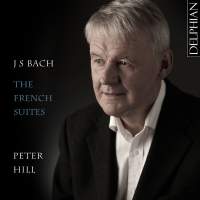Texte paru dans: / Appeared in: |
|
|
Outil de traduction ~ (Très approximatif) |
|
|
Reviewer: Scott
Noriega The British pianist Peter Hill has long dedicated himself to modern music. And in that field he has distinguished himself as one of its greatest proponents—only Peter Serkin immediately comes to mind in the same vein, as an advocate for music of this last century as much as music of the distant past. But while he has performed and recorded everything from Messiaen’s complete works and the complete published works of the Second Viennese School to the piano music of Dutilleux, Ravel, Stravinsky, Stockhausen, Murail, Takemitsu, and contemporaries such as Douglas Young and his long-time friend and piano-duo partner, George Benjamin, Hill too has long loved and admired the music of Bach. Having already recorded the Well-Tempered Clavier for Delphian, the pianist has now turned his attention to Bach’s French Suites. Though often thought of as lighter cousins to his more complex English Suites and Partitas, the French Suites offer the same remarkable clarity, genuine grace, and profundity as Bach’s greatest works. Lighter in texture never meant lighter in emotional output for this composer. Hill throughout chooses a more subdued, fluid approach to this music than do some. A number of the dances here greatly benefit from this tactic: The B-Minor Allemande feels at once stately and serious though never overly emotional. The pianist is careful to note its admixture of Baroque dance with its newer more galant-style textures and motives. His small additions and ornamentations on repeats are welcome in the freshness and spontaneity they bring without ever obscuring the musical lines. One of the highlights of this recording for me is Hill’s performance of the strange and enigmatic chorale-like D-Minor Sarabande. Hill rarely pushes the dynamic above piano. Here he lets the music speak for itself, only occasionally coloring certain of the more startling chords, lingering on them just a bit more than normal, and finally letting go when the music demands resolution. His sound throughout is beautiful, his ornaments clear, though not as crisp as Tureck’s or Gould’s more precise fingering, and his tempos are mostly on the relaxed side. Which is why, on occasion, I too have my reservations about his overall approach. Though many of the dances can be described as ceremonious or stately, some of the dances feel a bit too much of these things. Sometimes one wishes that Hill would burst forth with a bit more energy in movements such as the E ♭-Major Gavotte or the G-Major Gigue, both of which move at a rapid pace, but rhythmically feel unlike the dance which inspired them. Hill rounds off his recital with Mozart’s incomplete Suite, K 399, composed of a French Overture as prelude, an Allemande, a Courante, a Sarabande fragment completed by Hill, and the later independent G-Major Gigue, K 574. His approach to this music remains similar to the Bach, though here the Rococo and Baroque elements are reimagined. In his hands the music feels more Classical than Baroque and he is, as ever, inspired by the music which he plays. His sprightly account of the quirky final Gigue stays with one long after the recital has ended. Though I may have my quibbles regarding this recording, they are minor at most. Throughout Hill shows himself an accomplished musician, one whose head and heart work in tandem to bring out the music’s best qualities. This approach may not always work, and may not at all for some listeners who prefer a more rhythmically inspired dance-like approach to this music—those listeners may want to stick with a Schiff, a Hewitt, or even a Gould—but when Hill is successful, as he is here often in my opinion, his readings bring a whole new fresh understanding of this music. | |
|
|
|
|
Cliquez l'un ou l'autre
bouton pour découvrir bien d'autres critiques de CD |
|




